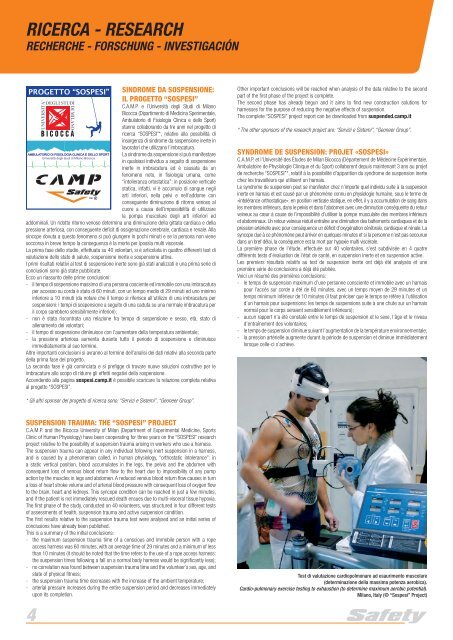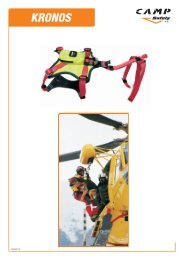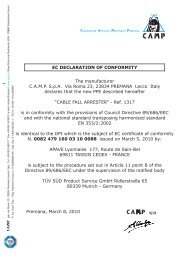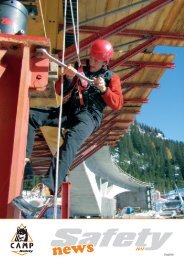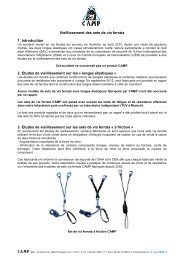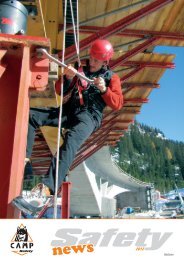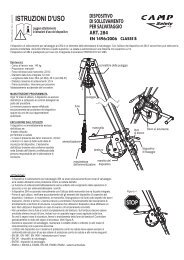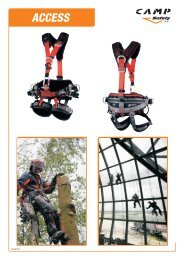You also want an ePaper? Increase the reach of your titles
YUMPU automatically turns print PDFs into web optimized ePapers that Google loves.
RICERCA - RESEARCH<br />
RECHERCHE - FORSCHUNG - INVESTIGACIÓN<br />
SINDROME DA SOSPENSIONE:<br />
IL PROGETTO “SOSPESI”<br />
C.A.M.P. e l’Università degli Studi di Milano<br />
Bicocca (Dipartimento di Medicina Sperimentale,<br />
Ambulatorio di Fisiologia Clinica e dello Sport)<br />
stanno collaborando da tre anni nel progetto di<br />
ricerca “SOSPESI”*, relativo alla possibilità di<br />
insorgenza di sindrome da sospensione inerte in<br />
lavoratori che utilizzano l’imbracatura.<br />
La sindrome da sospensione si può manifestare<br />
in qualsiasi individuo a seguito di sospensione<br />
inerte in imbracatura ed è causata da un<br />
fenomeno noto, in fisiologia umana, come<br />
“intolleranza ortostatica”: in posizione verticale<br />
statica, infatti, vi è accumulo di sangue negli<br />
arti inferiori, nella pelvi e nell’addome con<br />
conseguente diminuzione di ritorno venoso al<br />
cuore a causa dell’impossibilità di utilizzare<br />
la pompa muscolare degli arti inferiori ed<br />
addominali. Un ridotto ritorno venoso determina una diminuzione della gittata cardiaca e della<br />
pressione arteriosa, con conseguente deficit di ossigenazione cerebrale, cardiaca e renale. Alla<br />
sincope dovuta a questo fenomeno si può giungere in pochi minuti e se la persona non viene<br />
soccorsa in breve tempo la conseguenza è la morte per ipossia multi viscerale.<br />
La prima fase dello studio, effettuata su 40 volontari, si è articolata in quattro differenti test di<br />
valutazione dello stato di salute, sospensione inerte e sospensione attiva.<br />
I primi risultati relativi al test di sospensione inerte sono già stati analizzati e una prima serie di<br />
conclusioni sono già state pubblicate.<br />
Ecco un riassunto delle prime conclusioni:<br />
- il tempo di sospensione massimo di una persona cosciente ed immobile con una imbracatura<br />
per accesso su corda è stato di 60 minuti, con un tempo medio di 29 minuti ed uno minimo<br />
inferiore a 10 minuti (da notare che il tempo si riferisce all’utilizzo di una imbracatura per<br />
sospensioni: i tempi di sospensione a seguito di una caduta su una normale imbracatura per<br />
il corpo sarebbero sensibilmente inferiori);<br />
- non è stata riscontrata una relazione fra tempo di sospensione e sesso, età, stato di<br />
allenamento dei volontari;<br />
- il tempo di sospensione diminuisce con l’aumentare della temperatura ambientale;<br />
- la pressione arteriosa aumenta durante tutto il periodo di sospensione e diminuisce<br />
immediatamente al suo termine.<br />
Altre importanti conclusioni si avranno al termine dell’analisi dei dati relativi alla seconda parte<br />
della prima fase del progetto.<br />
La seconda fase è già cominciata e si prefigge di trovare nuove soluzioni costruttive per le<br />
imbracature allo scopo di ridurre gli effetti negativi della sospensione.<br />
Accendendo alla pagina sospesi.camp.it è possibile scaricare la relazione completa relativa<br />
al progetto “SOSPESI”.<br />
Other important conclusions will be reached when analysis of the data relative to the second<br />
part of the first phase of the project is complete.<br />
The second phase has already begun and it aims to find new construction solutions for<br />
harnesses for the purpose of reducing the negative effects of suspension.<br />
The complete “SOSPESI” project report can be downloaded from suspended.camp.it<br />
* The other sponsors of the research project are: “Servizi e Sistemi”, “Geoneer Group”.<br />
SYNDROME DE SUSPENSION: PROJET «SOSPESI»<br />
C.A.M.P. et l’Université des Études de Milan Bicocca (Département de Médecine Expérimentale,<br />
Ambulatoire de Physiologie Clinique et du Sport) collaborent depuis maintenant 3 ans au projet<br />
de recherche “SOSPESI”*, relatif à la possibilité d’apparition du syndrome de suspension inerte<br />
chez les travailleurs qui utilisent un harnais.<br />
Le syndrome de suspension peut se manifester chez n’importe quel individu suite à la suspension<br />
inerte en harnais et est causé par un phénomène connu en physiologie humaine, sous le terme de<br />
«intolérance orthostatique»: en position verticale statique, en effet, il y a accumulation de sang dans<br />
les membres inférieurs, dans le pelvis et dans l’abdomen avec une diminution conséquente du retour<br />
veineux au cœur à cause de l’impossibilité d’utiliser la pompe musculaire des membres inférieurs<br />
et abdominaux. Un retour veineux réduit entraîne une diminution des battements cardiaques et de la<br />
pression artérielle avec pour conséquence un déficit d’oxygénation cérébrale, cardiaque et rénale. La<br />
syncope due à ce phénomène peut arriver en quelques minutes et si la personne n’est pas secourue<br />
dans un bref délai, la conséquence est la mort par hypoxie multi viscérale.<br />
La première phase de l’étude, effectuée sur 40 volontaires, s’est subdivisée en 4 quatre<br />
différents tests d’évaluation de l’état de santé, en suspension inerte et en suspension active.<br />
Les premiers résultats relatifs au test de suspension inerte ont déjà été analysés et une<br />
première série de conclusions a déjà été publiée.<br />
Voici un résumé des premières conclusions:<br />
- le temps de suspension maximum d’une personne consciente et immobile avec un harnais<br />
pour l’accès sur corde a été de 60 minutes, avec un temps moyen de 29 minutes et un<br />
temps minimum inférieur de 10 minutes (il faut préciser que le temps se réfère à l’utilisation<br />
d’un harnais pour suspensions: les temps de suspensions suite à une chute sur un harnais<br />
normal pour le corps seraient sensiblement inférieurs);<br />
- aucun rapport n’a été constaté entre le temps de suspension et le sexe, l’âge et le niveau<br />
d’entraînement des volontaires;<br />
- le temps de suspension diminue suivant l’augmentation de la température environnementale;<br />
- la pression artérielle augmente durant la période de suspension et diminue immédiatement<br />
lorsque celle-ci s’achève.<br />
* Gli altri sponsor del progetto di ricerca sono: “Servizi e Sistemi”, “Geoneer Group”.<br />
SUSPENSION TRAUMA: THE “SOSPESI” PROJECT<br />
C.A.M.P. and the Bicocca University of Milan (Department of Experimental Medicine, Sports<br />
Clinic of Human Physiology) have been cooperating for three years on the “SOSPESI” research<br />
project relative to the possibility of suspension trauma arising in workers who use a harness.<br />
The suspension trauma can appear in any individual following inert suspension in a harness,<br />
and is caused by a phenomenon called, in human physiology, “orthostatic intolerance”: in<br />
a static vertical position, blood accumulates in the legs, the pelvis and the abdomen with<br />
consequent loss of venous blood return flow to the heart due to impossibility of any pump<br />
action by the muscles in legs and abdomen. A reduced venous blood return flow causes in turn<br />
a loss of heart stroke volume and of arterial blood pressure with consequent loss of oxygen flow<br />
to the brain, heart and kidneys. This syncope condition can be reached in just a few minutes,<br />
and if the patient is not immediately rescued death ensues due to multi-visceral tissue hypoxia.<br />
The first phase of the study, conducted on 40 volunteers, was structured in four different tests<br />
of assessments of health, suspension trauma and active suspension condition.<br />
The first results relative to the suspension trauma test were analysed and an initial series of<br />
conclusions have already been published.<br />
This is a summary of the initial conclusions:<br />
- the maximum suspension trauma time of a conscious and immobile person with a rope<br />
access harness was 60 minutes, with an average time of 29 minutes and a minimum of less<br />
than 10 minutes (it should be noted that the time refers to the use of a rope access harness:<br />
the suspension times following a fall on a normal body harness would be significantly less);<br />
- no correlation was found between suspension trauma time and the volunteer’s sex, age, and<br />
state of physical fitness;<br />
- the suspension trauma time decreases with the increase of the ambient temperature;<br />
- arterial pressure increases during the entire suspension period and decreases immediately<br />
upon its completion.<br />
4<br />
Test di valutazione cardiopolmonare ad esaurimento muscolare<br />
(determinazione della massima potenza aerobica).<br />
Cardio-pulmonary exercise testing to exhaustion (to determine maximum aerobic potential).<br />
Milano, Italy (© “Sospesi” Project)


